Update 10/29/24:
Sporting CP has confirmed that Rúben Amorim is leaving to become the new Manchester United manager.
The History Of Portuguese Coaches
Portugal has long been a hotbed of coaching talent within the footballing world, ever since the ‘Special One’ Jose Mourinho burst onto the scene in the 2003/04 season.
That year saw Mourinho lead Porto to the Champions League, an overperformance that defied all expectations.
The Portuguese coach then joined Chelsea and instigated a period of dominance over English football for the London club.
There is a tendency within football, especially amongst coaches and analysts, to be caught up in whichever brand of football is successful at that moment.
At this point, Portuguese football was in the limelight, and the methods of training and youth development were dissected and analysed as people tried to find the secret of their success.
This led to widespread buy-in at the professional level for tactical periodization, a training methodology that used advised sessions and training cycles that kept the critical moments of the game as their centrepiece.
In other words, this idea led coaches away from traditional fitness work, which involved running in isolation, to a style in which players did fitness work within specific drills with the ball at their feet.
Mourinho was a key advocate for tactical periodization, having studied under Vitor Frade, the university professor who created it.
From this point on, Portuguese coaches became coveted, with the likes of Paulo Fonseca, Andre Villas-Boas and Nuno Espírito Santo becoming established in major European leagues.
Now, a new Portuguese coach is coming through who is drawing admiring glances from across the continent—Ruben Amorim.
Who is Rúben Amorim?
Rúben Amorim is a 35-year-old Portuguese coach who had a long career as a professional player.
He played mainly for two sides, Sporting Braga and Benfica, and represented Portugal at international level on fourteen occasions.
He was a primarily functional midfielder and a good professional but never a player who stood out particularly for any individual brilliance.
Upon his retirement in 2017, Amorim immediately started working on his coaching badges, and in the 2018/19 season, he accepted a coaching position with Casa Pia in the Portuguese lower leagues.
Unfortunately, he still had not achieved the necessary qualifications to coach from the sidelines, and the club was fined and deducted points when he did so.
Those punishments were lifted on appeal, but Amorim tendered his resignation on principle.
He then agreed the following season to take charge of the Braga B team in the third tier.
After a matter of months, Amorim was promoted to the first team and started a run that attracted significant interest.
Over the few months he spent at the club, he led Braga to wins over the traditional big three (Porto, Benfica, and Sporting CP) and won a trophy.
Braga won the League Cup with a win over Porto in the final.
More than just the success, however, Amorim was attracting interest because of his style of play.
This interest manifested itself in Sporting CP agreeing to pay a £10M release in Amorim’s contract to take the coach to Lisbon.
Rúben Amorim Style of play
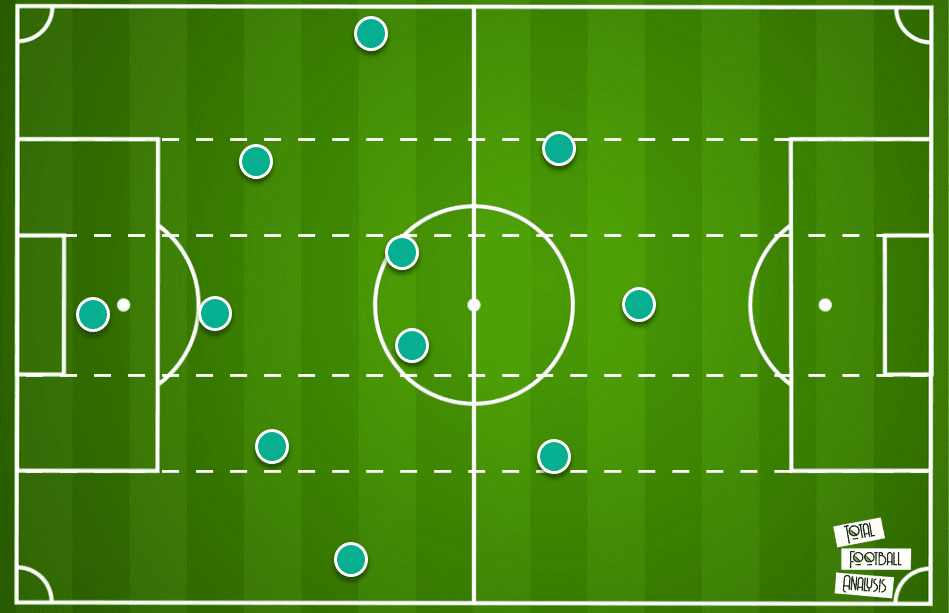
Rúben Amorim’s coaching style favours almost exclusively a 3-4-3 system with a lot of fluid movement in the attacking phase.
Indeed, so far this season, Sporting has used Rúben Amorim’s system 83% of the time, with the other 17% spent in a 3-4-1-2 variant.
He is a coach who incorporates elements of positional play into his game model.
He tends to create overloads in the half-spaces and build up through vertical passes that find players in pockets of space within the opposition’s defensive structure.
In the defensive phase, Ruben Amorim likes to counter-press and then move aggressively to win the ball back as close to the opposition goal as he can.
A quick look at the statistics at the time of writing further displays this.
Sporting CP currently sit at the top of the table and are averaging 2.6 goals per 90 minutes.
This is no surprise
, given that they are averaging 13.03 shots per 90 minutes and 17.45 touches in the opposition area per 90 minutes.
In terms of their tendencies in possession they are averaging 427.63 passes per 90 but 65.47 of these are listed as progressive passes.
In the defensive phase, they have a PPDA (passes per defensive action) of 8.14 and are known as a side that will press aggressively when out of possession.
Rúben Amorim Out Of Possession
First of all we will consider the tendencies that we see from Amorim’s sides out of possession.
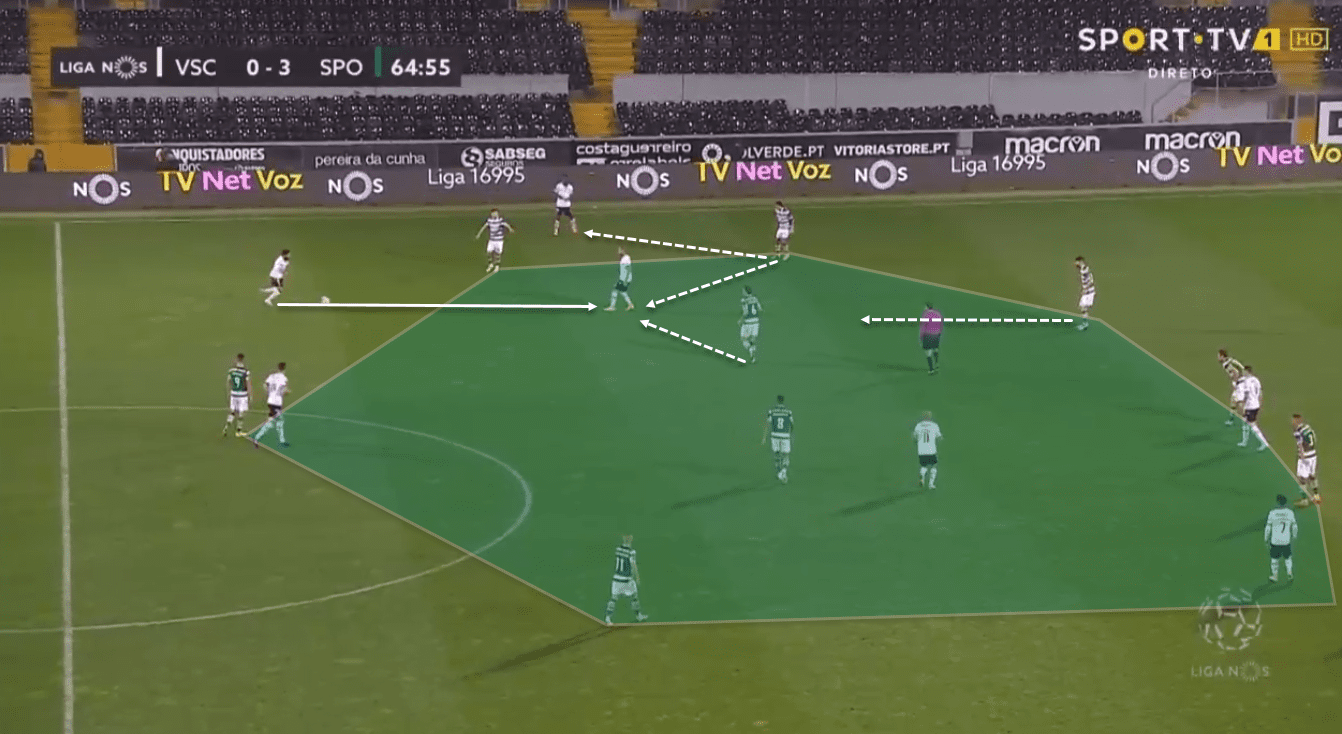
In the established defensive phase, Sporting CP tends to adopt a 5-4-1 formation, with the wingbacks dropping back into the first line and the attacking wide players dropping to the second line.
This leaves the ‘9’ as the only player who tends to act by pressing the ball and slowing the opposition’s progression.
Of course, this shape is very fluid. When the opportunity arises for a second player to join the press, one of the wide attackers will join the ‘9’, with the second line shifting across to account for this positioning.
The main focus is on keeping the defensive structure compact to prevent the opposition from easily breaking through.
As you can see from this image, however, there is still a tendency for the ball to be pressed aggressively when it is played into a dangerous area.
Here we see the opposition looking to build-play and progress the ball.
As the ball is played into the defensive structure, though, Sporting CP moves immediately to apply pressure to force a turnover in possession.
The two closest midfielders are quick to close at an angle, and the free CB, who is on the ball’s line, moves forward to press and engage.
This leaves three players pressing and engaging the ball, and Sporting CP wins the ball and transitions into the attacking moment.
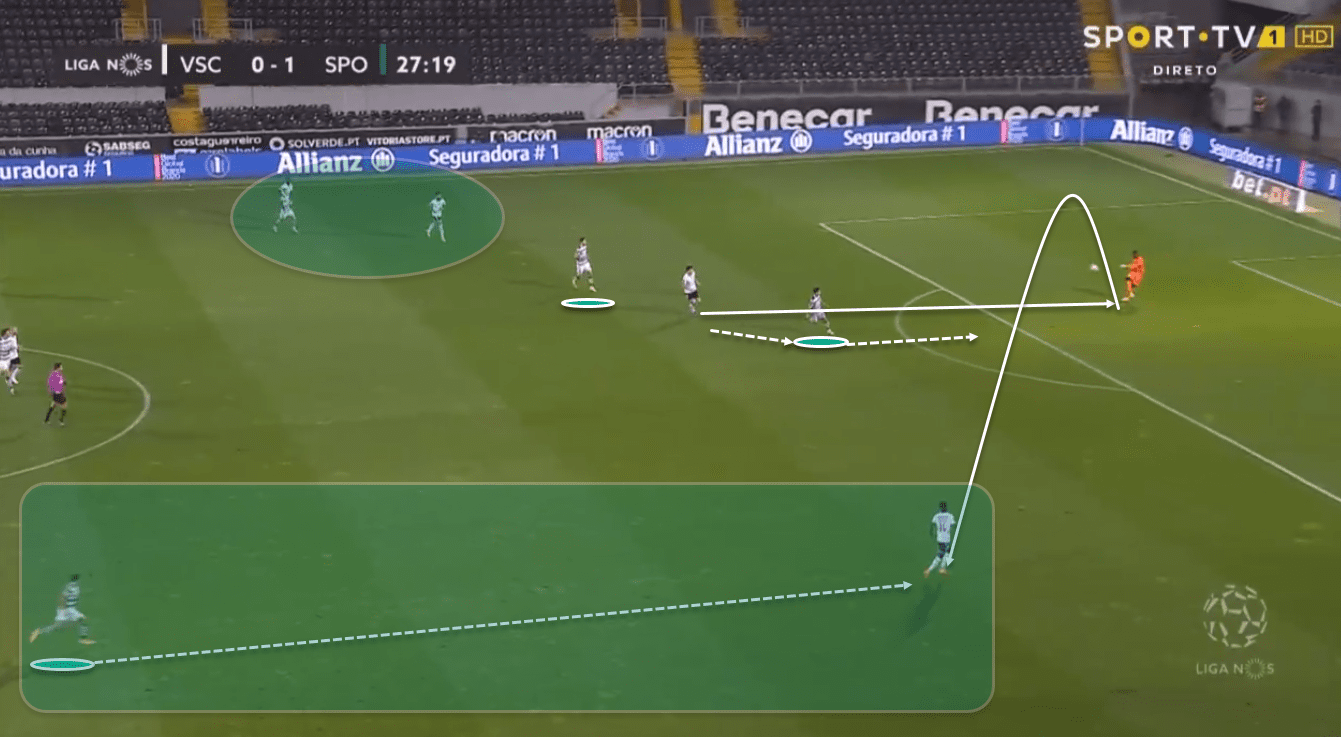
Now, we will examine just how aggressively Sporting CP presses to try to win the ball back quickly.
As the opposition have recycled the ball back towards the goalkeeper the ‘9’ is moving to press the ball.
The goalkeeper looks to access the near-side player to escape the press, and he is initially in space.
The goalkeeper, however, loops the pass into the air, which allows Sporting CP’s near-side player to make up considerable ground as he moves to engage the receiving player.
As the ball drops, the pressing player is in position, and the ball is won as Sporting CP looks to immediately attack the goal.
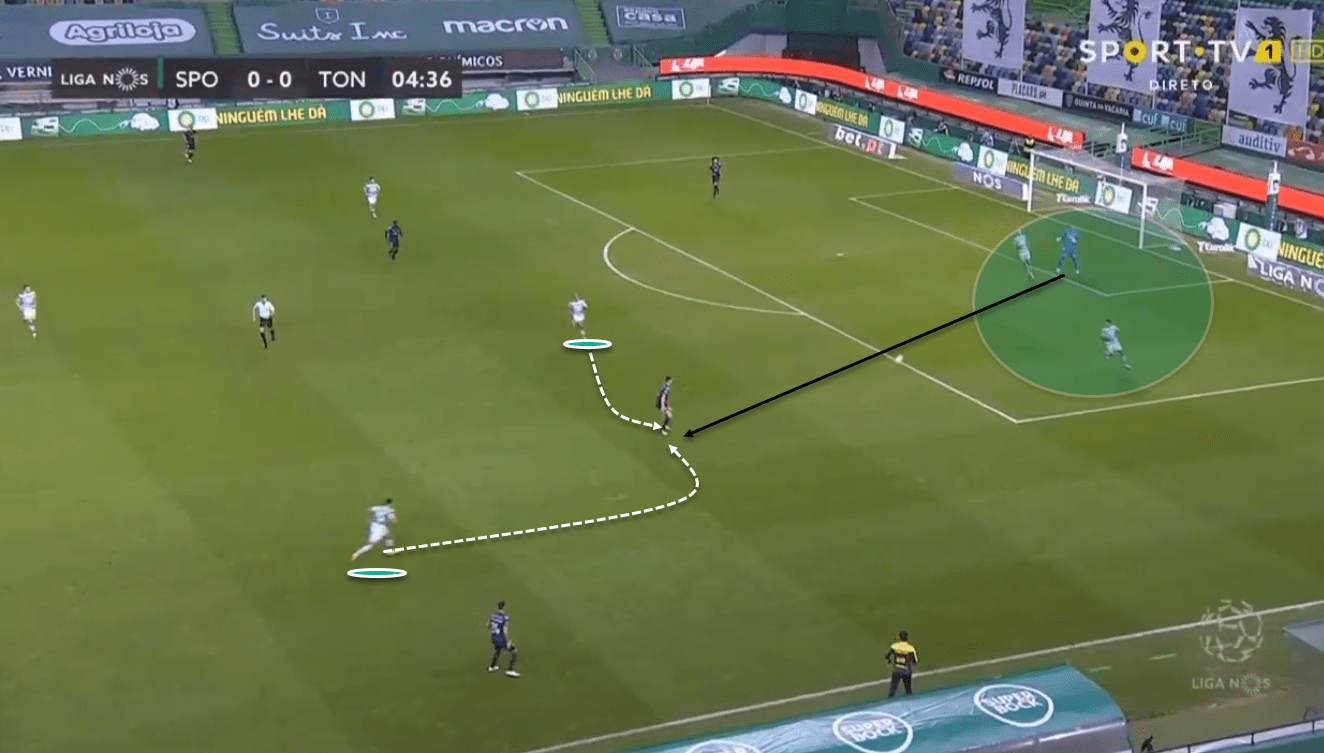
There is a similar situation here: the opposition goalkeeper receives the ball under considerable pressure from the Sporting CP press.
He immediately looks to play through the press to a teammate who is looking in space and facing his own goal.
As soon as this press is played, we see two defensive players from Sporting CP, who have initially been positioned behind the press to support it, move to engage and press the receiver.
Once again, the ball is won, and they can look to move quickly to attack the opposition’s goal.
Rúben Amorim Moments Of Transition
Under Ruben Amorim’s tactics, Sporting CP is a side that plays in transition, with great fluidity between the positions on the pitch.
The main principle in the defensive transition is to recover positions and delay the attack of the opposition.
This tends to be achieved through one player applying pressure and slowing down the ball progression whilst the others crash back to their defensive shape.
The main underlying concept of the attacking transition surrounds the number of players that Amorim likes to commit forward to quickly overload and outplay the opposition’s defensive block.
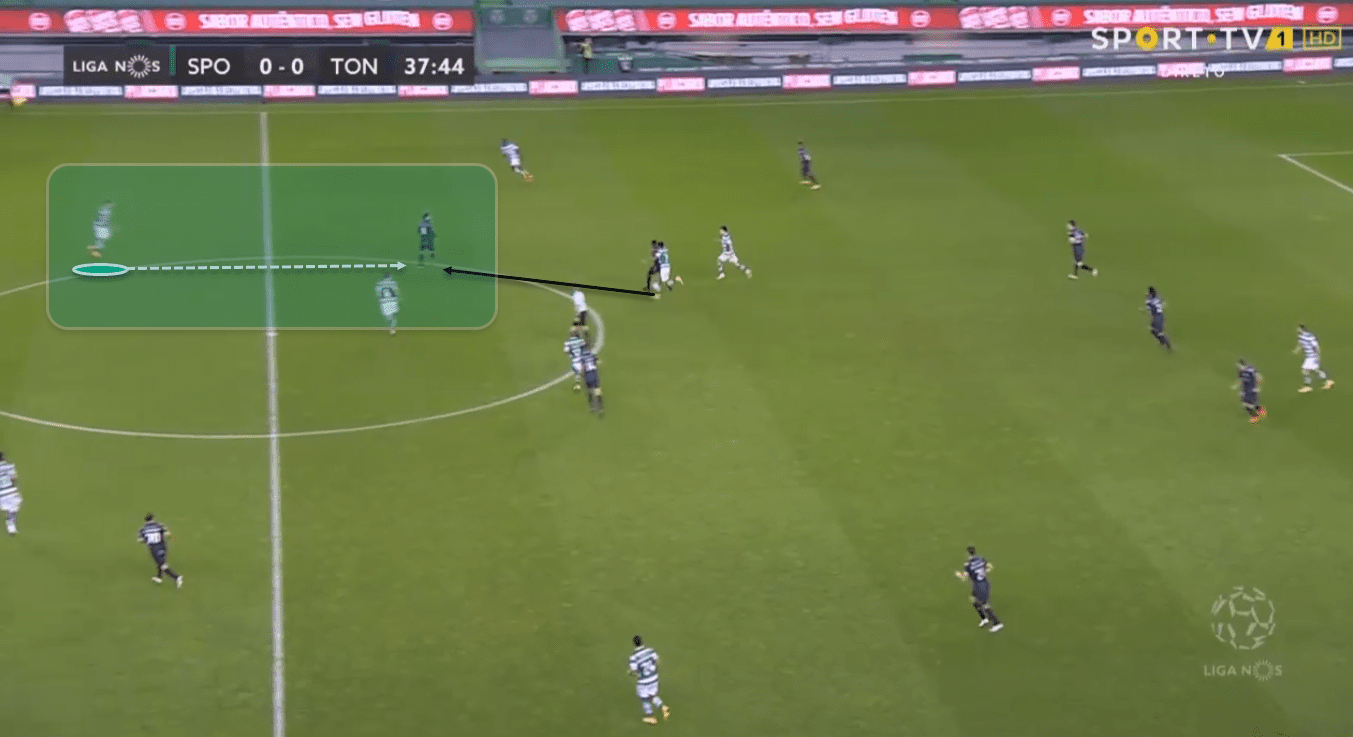
Here we have a moment in the transition for Sporting CP from attack to defence.
The opposition has immediate positional superiority, as many players from Sporting CP are caught behind the ball.
The opposition plays a vertical pass to connect to an attacker in space on a higher line.
However, as that pass is played, the central defender, who is free on the first line, moves quickly to aggressively engage the ball.
As the defender steps forward, he is able to quickly win the ball back.
This then creates an opportunity for Sporting CP to attack as the opposition has players caught out of position.
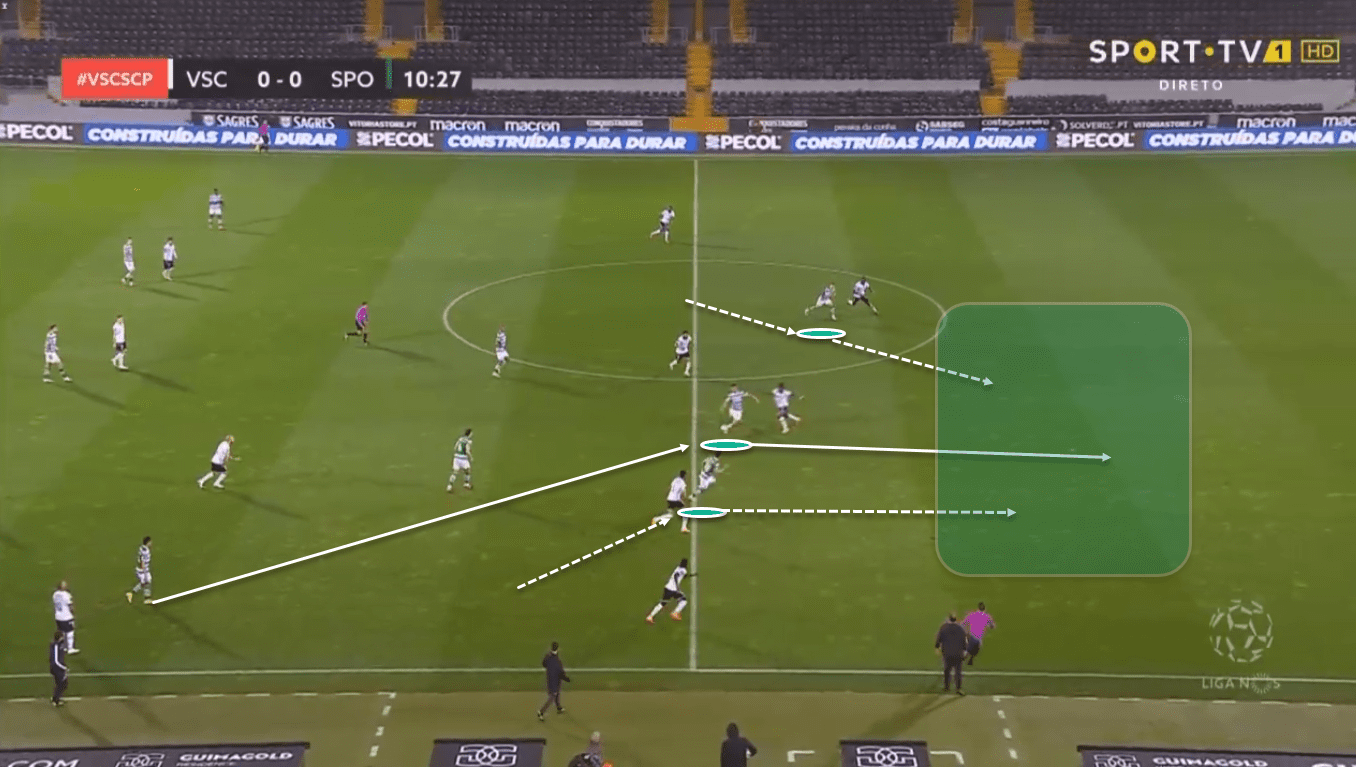
This time the transition is from the defensive phase to the attacking phase.
As the ball is won back in wide space, three Sporting CP players are on the highest line, ready to outplay the opposition’s defensive line.
The ‘9’ immediately shows for the ball and allows the man in possession initially to look for a vertical passing option.
This movement from the ‘9’, back towards the ball, pulls a defensive marker out of their positional slot.
This creates a space in the defensive line of the opposition that can be quickly attacked.
As the ball is played into the ‘9,’ both wide attackers are looking to make quick diagonal passes into the space created by the movement of the ‘9’.
This allows for a quick combination to be played as Sporting CP break through on the opposition goal.
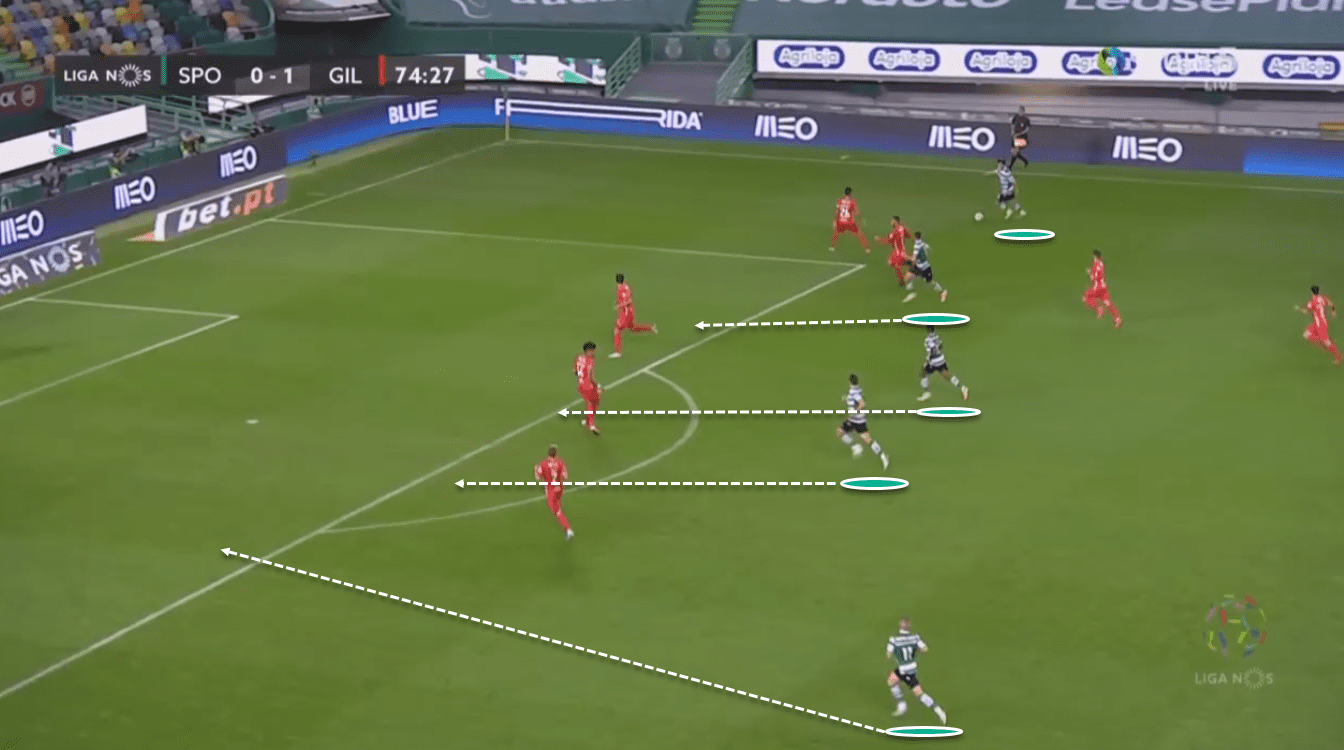
Finally, when talking specifically about the transition phase, we need to discuss the fact that Amorim is extremely aggressive in committing players forward in the attacking transition.
He wants his team to access the penalty area from as many angles and depths as possible to overwhelm the opposition penalty area.
We see this in this image: With the ball in the wide space, four Sporting CP players move forward to try to break into the opposition area and create an opportunity to score.
Rúben Amorim Attacking Phase
In the attacking phase, we begin to see Amorim adopt several concepts that belong to football’s positional play concept.
He likes his players to occupy the half-space and receive the ball in areas of the pitch that can immediately hurt the opposition’s defensive structure.
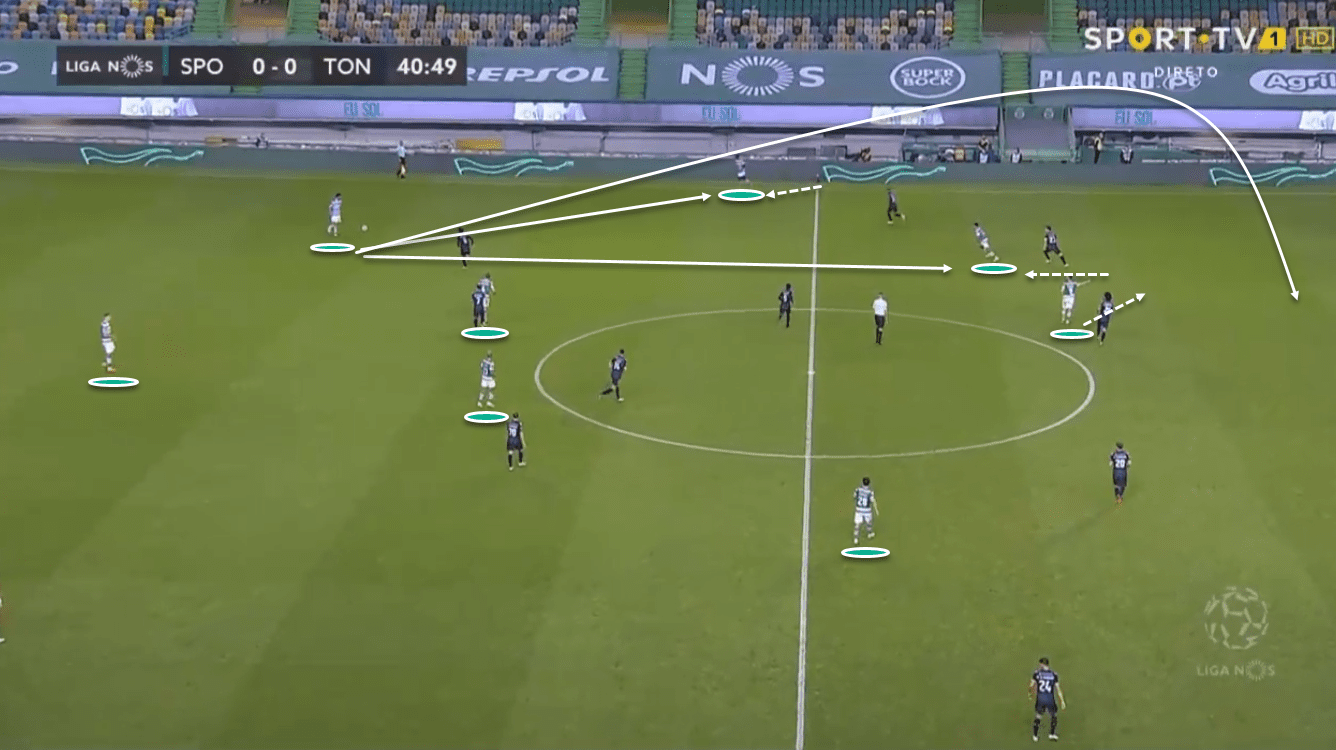
This is especially important in the build-up phase as Sporting CP look to create passing options on different levels when the wide central defenders are in possession of the ball.
We have an example of this here with the left-sided central defender in possession of the ball.
There are two players, left-wing back and wide attacker moving back towards the ball.
This creates vertical passing options in the wide space and in the half-space.
These rotations, as the two players move back towards the ball, create an opportunity for the ‘9’ to rotate back towards the ball with a diagonal run on the ball side of the field.
Now the man in possession has three clear passing options with which to progress and outplay the opposition.

A similar situation here with the left-sided central defender again in possession of the ball.
The wingback on the far side moves towards the ball, and the wide attacker is again positioned in half space.
Look at the positions of the wide attacker and the ‘9’, who are both in pockets of space between defensive players.
The ‘9’ again has the option to stretch the opposition’s defensive structure vertically to allow the vertical pass over the top.

As the ball moves forward into more advanced positions, Amorim coaches his teams to create overloads on one side of the field to play through the opposition’s defensive structure.
We see an example of this here where the ball is positioned initially with one of the central midfielders in the near-side half-space.
The ‘9’ drops back to provide a passing option at the top of the diamond, and the right-winger and right-wing back are also positioned intelligently to support the man in possession of the ball.
As the ball travels vertically towards the ‘9’, the wingback makes an intelligent move on the blindside of the opposition defenders and looks to access space behind the defensive line.
The pass is then spun behind to access this space, and Sporting CP immediately outplays the opposition.
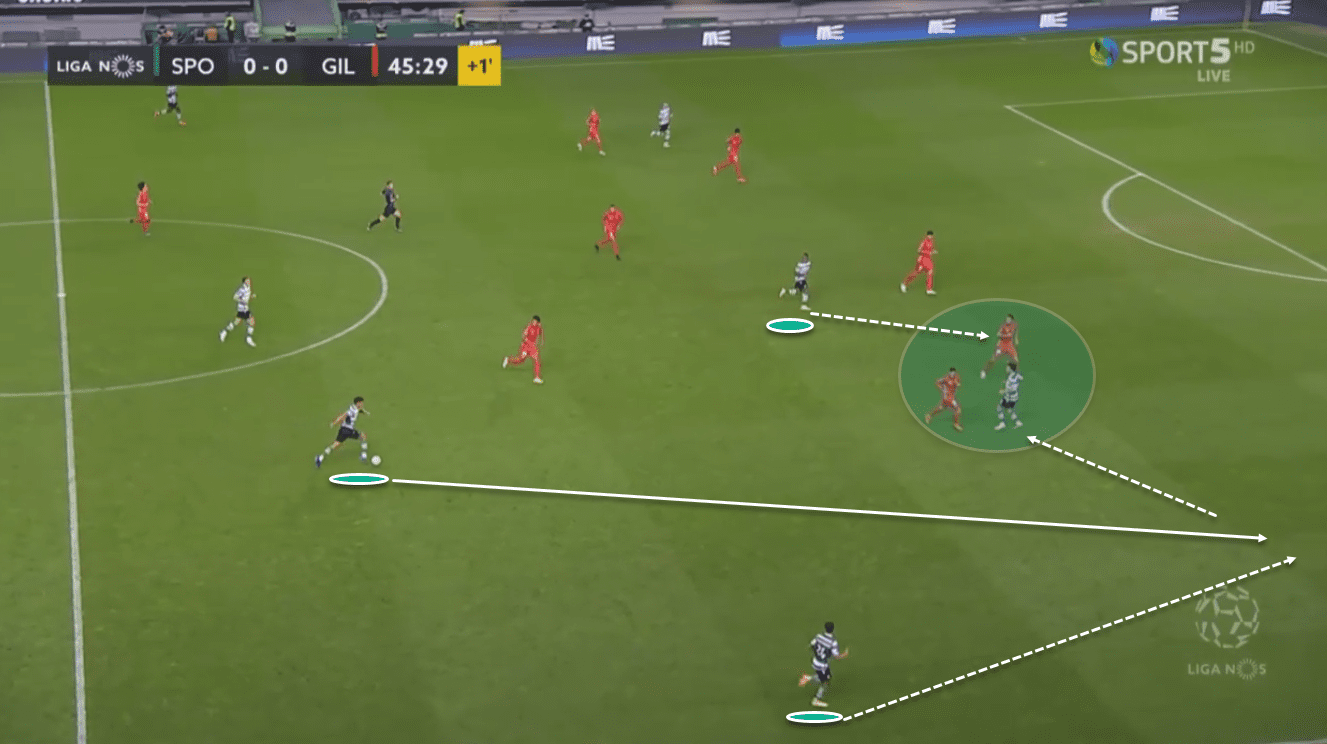
Here, we see another example of how, under Amorim, Sporting CP likes to create opportunities to outplay the opposition’s defensive line in the attacking phase.
Initially the near side wide attacker has moved inside into the half-space.
This drags his marker inside with him and opens up space in the wide area that the wingback can attack.
One of the two defensive players in the half-space would normally rotate out to cover the wingback’s run, but the diagonal movement of the ‘9’ into the half-space pins those players centrally.
This opens the possibility for a pass in the wide area, and immediately, the ball can be moved behind the line.
Conclusion
In his short coaching career so far Ruben Amorim has impressed at every step.
He has shown that he can support his team in adopting complicated tactical concepts regardless of the quality of the individual talent that they have.
This is a sign of a coach with excellent communication skills.
Sporting CP’s issue is that as the coach’s profile continues to grow, so does the chance that Amorim will be tempted to move to a major league.
2021 is likely to see Amorim continue to develop his reputation as a coach.





Comments